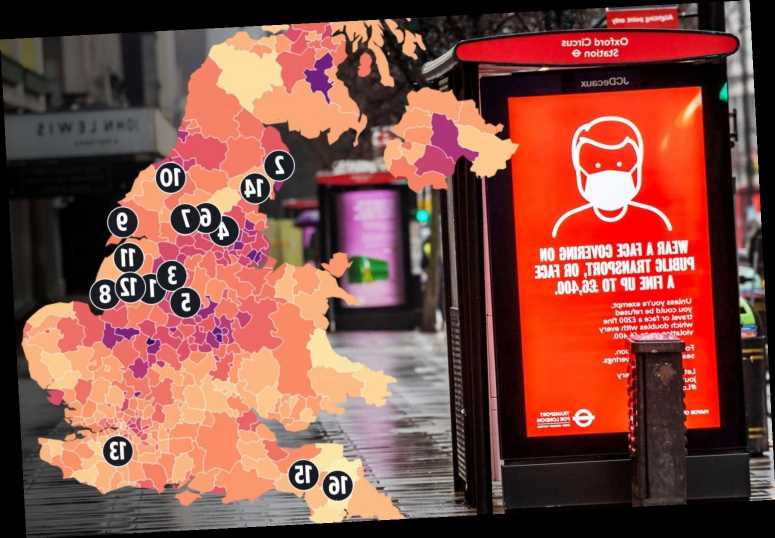CORONAVIRUS infections are still rising in 16 places in England and this interactive map reveals if your area is on the list.
Data from Public Health England (PHE) states that 95 per cent of local authorities have seen a fall in cases in the last seven days.
? Read our coronavirus live blog for the latest news & updates
The data from PHE comes after experts revealed the four steps the government needs to take in order for lockdown restrictions to be eased.
An NHS chief has told Prime Minister Boris Johnson that he should focus on "data and not just dates", before easing lockdown.
Chris Hopson, chief executive of NHS Providers, which represents NHS trusts in England has written to the PM to discuss what requirements need to be met.
He said the pressure needs to be eased on the NHS and the vaccine drive needs to continue before lockdown can be lifted.
Mr Hopson also highlighted that a plan would need to be in place in order to control new outbreaks and variants.
But first he said – the number of infections needed to fall.
Fewer cases of coronavirus mean fewer hospitalisations and fewer deaths.
PHE states that in the seven days up to February 12, cases have fallen in 299 areas in England.
This means that they have increased in just 16 areas.
Newark and Sherwood in Nottinghamshire is one of the 16 areas that have seen an increase in infections and in the last seven days cases have gone from 215.6 to 255.7 per 100,000.
It was this morning reported that another 23 cases had been confirmed in the area.
'DON'T LET YOUR GUARD DOWN'
Copeland in Cumbria has also jumped from 159.9 to 247.9 and a spokesperson for the local council said that the increase was mainly down to a few small outbreaks that were being "closely monitored and contained".
Despite this Copeland Borough Council's Carl Walmsley suspected that people in the area had "let their guard down".
He said: "I cannot stress enough that this is nowhere near over, we need to remain vigilant and follow guidelines at all times."
Rushcliffe in Nottinghamshire has also witnessed an increase in infections, going from 189.6 to 215.6.
Looking further North and Bury in Greater Manchester has also seen a rise in cases, going from 196.3 to 205.8.
North West Leicestershire has also seen an increase, going from 196.9 to 202.7.
In the North West, Tameside also witnessed a jump, going from 186.8 to 200 and despite a rise in infections, it's not the most infections place in Greater Manchester, sitting behind Bolton, Salford and Bury.
Calderdale in West Yorkshire has seen a jump from 177.3 to 191.1 and sadly in the last 24 hours six new coronavirus deaths have been recorded at Calderdale and Huddersfield Trust.
Boston in Lincolnshire has seen a rise in cases, going from 182.4 to 186.7.
Cases of the virus in Hull in East Yorkshire have also gone up from 159 to 163.2.
Another area that has witnessed an increase in cases in Hambleton in North Yorkshire.
Infections here have jumped from 124.5 to 140.8.
Today frontline social care workers in the area were urged to sign up to get the vaccine in order to stop the transmission of Covid-19.
West Lindsey in Lincolnshire has jumped from 84.7 to 128.6 and Lincoln has jumped from 91.6 to 125.9.
'NO ROOM FOR COMPLACENCY'
Cases in Mole Valley in Surrey have also increased from 100.9 to 105.5.
Local councillors have warned residents that just a couple of families can have an impact when it comes to a rise in infection rates.
Fetcham West district councillor Paul Kennedy said there is "no room for complacency" and added that he would not support lifting a lockdown.
Cases have also increased in South Lakeland in in Cumbria going from 82.8 per 100,000 to 92.3.
Exeter has also seen a big jump in cases, going from 30.4 to 79.1 in the last seven days.
East Devon also witnessed an increase from 55.4 to 64.9.
While the 16 areas above have witnessed an increase in cases, some of the most infected places in the country have seen a fall in figures.
Middlesbrough has the highest rate in England, with 449 new cases recorded in the seven days to February 12 – the equivalent of 318.5 cases per 100,000 people.
This is down from 356.8 cases per 100,000 people in the seven days to February 5.
Corby in Northamptonshire has the second highest rate, down from 432.0 to 315.7, with 228 new cases.
Sandwell in the West Midlands is in third place, down from 409.5 to 291.7, with 958 new cases.
Source: Read Full Article



